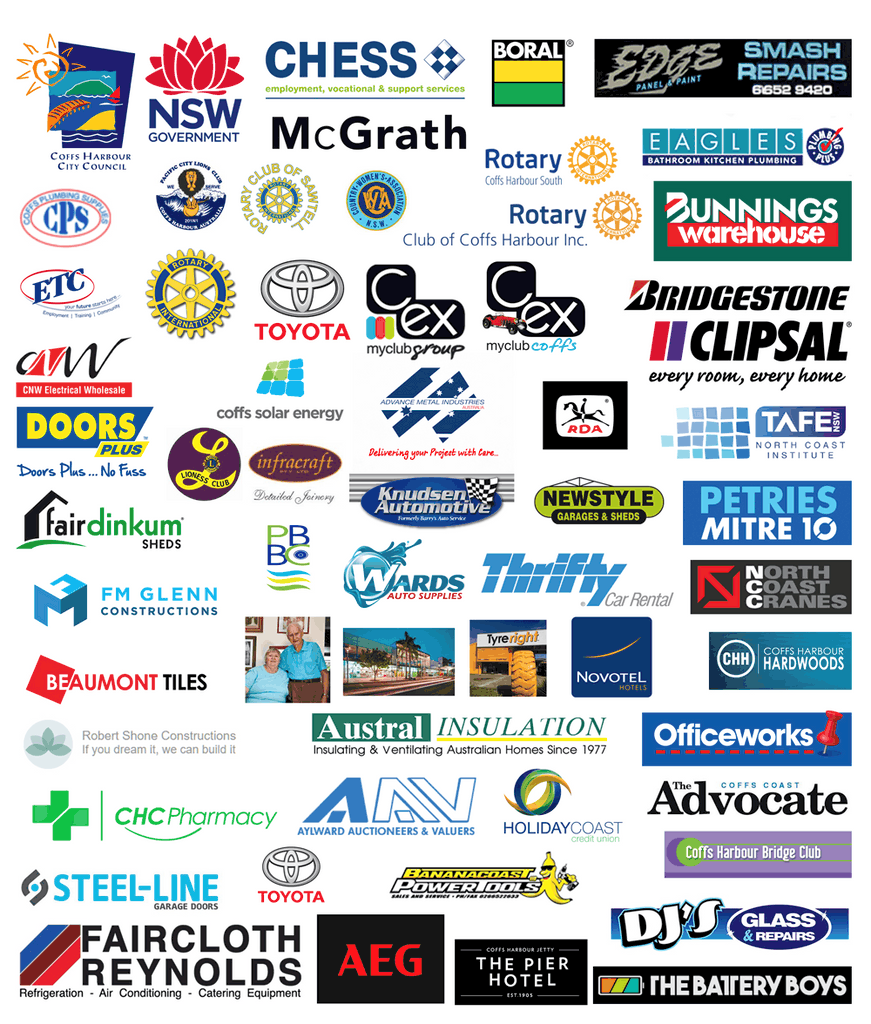May 2018 Newsletter
Presidents Message
This is the first newsletter to be published by Ray Meyer with articles provided by various members. Doug Simpson has decided to finish compiling the newsletter after about 5 years of excellent and interesting newsletters. Thanks Doug for the many hours you have spent putting the newsletter together. Also thanks to Clive Longstaff who assisted Doug for the past few months. Anyone interested in helping to compile the newsletter, please advise myself or Robert.
The men’s shed has been actively represented at various functions over the past few weeks. The Woodworkers held their displays on the 7th and 8th April and we were there with a table of our work. On the 15th April the shed was represented at the Jetty Markets to be involved in the Senior’s Week activities. On 27th and 28th April our
shed had a display at the Coffs Harbour Show and without the valued support of members who volunteered to man these displays, we would not have been able to show the community what the men’s shed has to offer. A big thank you to all concerned and in particular Robert, who organised and set up the displays.
Some of you may have witnessed the “spectacle” around the large thicknesser last week. In reality, it was Tom and Bruce overhauling the machine including the fitting of new blades and lubricating and adjusting the mechanicals. The thicknesser is now fully operational with thanks to Tom and Bruce. It was great entertainment! Now there is no need to put hardwood through the small thicknesser.
We recently engaged a Structural Engineer to check the mezzanine and we have carried out his recommendations with some minor building work. This is part of the requirements to obtain a Building Certificate to complete all structural work in the shed.
Editorial
Welcome to the new 'look' newsletter from the Coffs Harbour Community Men's Shed. As the membership grows (currently 165) we are tasked with better lines of communication and we need to be more open to our sponsors and supporters. With this issue the newsletter is being sent to a growing list of people outside the shed, including sponsors, supporters and friends of the Shed. Also, we will endeavour to present Community Events that you may have missed, future events, some archival photos from around Coffs Harbour, hints and tips, a regular column by Barry Guest about the "do's and don'ts" of shed work, plus submitted articles by shedders, keeping everyone informed of the latest activities inside the shed.
Get involved.
If you want to contribute, email articles, pics etc to Mail:
coffsharbourmensshed@gmail.com
This newsletter will be available through the Men's Shed Website at:

Spray Painters Required
Are you interested in learning how to spray paint? The Shed needs members to help out in the Paint Booth, and we have Professionals willing to teach us how. If you want to learn the correct methods of spray painting, preparation, lacquering, sanding and cleaning, then contact the office (Robert or David). These skills will
help you with better finishing of your own work, plus give Glenn some needed help and time off to pursue his own work.

Flu Season
Members are requested to consider everyone else when it comes to sickness. The Flu season is upon us, and if you are unfortunate to catch the flu, don't spread it around. Stay at home - rest and recuperate. Flu shots are effective (not 100%) and can have some side effects, but in general are much safer than a bout of influenza,
especially for the older members, so get a shot now if you haven't had one yet...

Shed Clean-up Week
A planned closure of the Shed for 1 week will be organised soon. We need volunteers to help with the work. A general buildup of dust requires annual removal for reasons of fire safety, health and safety issues, and will allow us to also do a stocktake of assets.
The Shed will not re-open until the cleanup is finished, so more volunteers means less days lost to the public and members. The date will be posted at the Shed and webiste, plus we will send an email out to all members with email addresses.
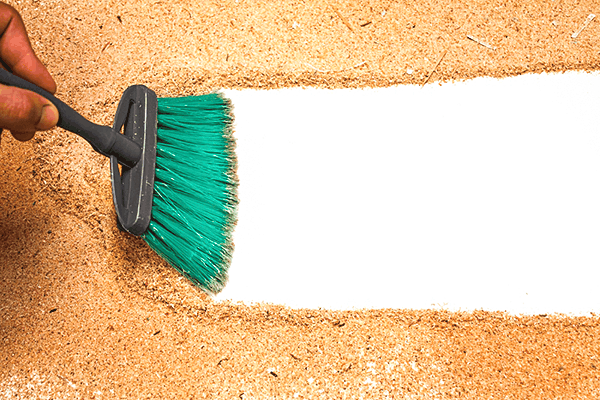
Around the Workshop

Tom Skinner with his door to nowhere, but he’s not telling.
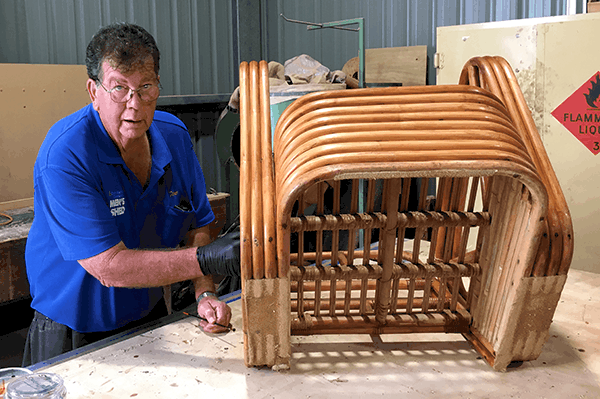
Dave Churchyard thoroughly enjoying the restoration of cane chairs.
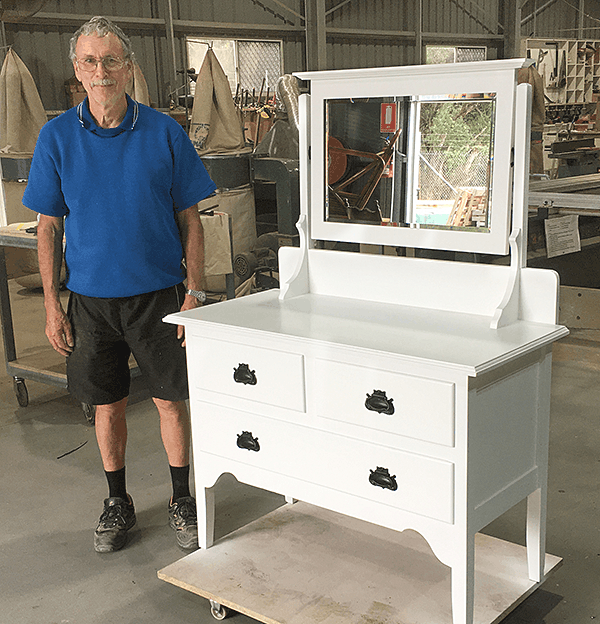

Do you know what you're looking at?
This is what happens when a fine leather sandal is repaired by a carpenter -
the screw isn't even stainless!
Okay, so who is the culprit?
Barry Guess Guest, that's who...
Can you play?
Word had got around that Barry (our resident luthier) was offering to mentor a group at the shed who were keen to make a guitar. Always on the lookout for new projects to improve my knowledge and skills with anything to do with wood, I discussed with Barry the possibility of getting involved as the group had been going for sometime while I was away. As always, he was happy to include anybody who was interested in having a go. Encouraged I pulled in two mates who joined as well.
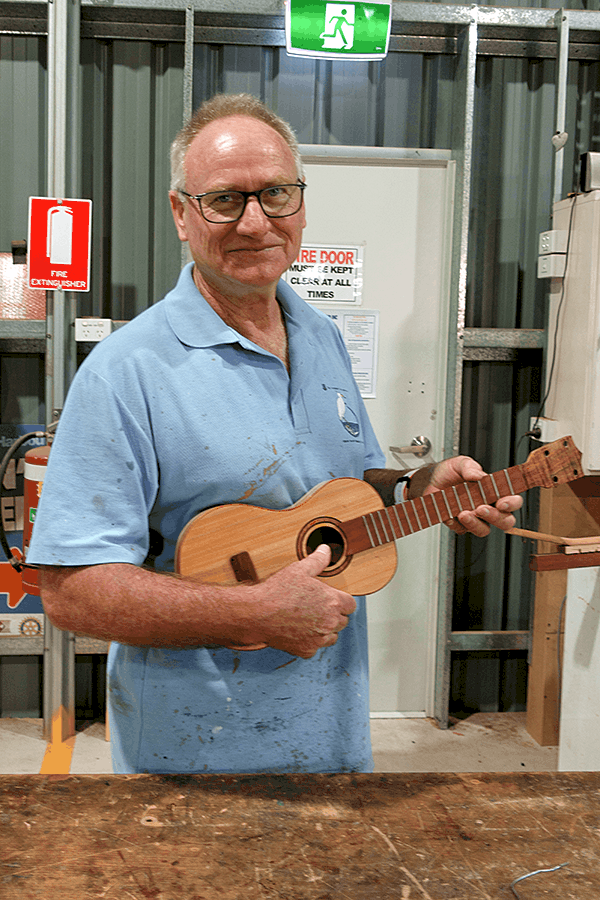

with wood braces as described in the plan. Then the top and sides are glued together using small right angle wooden wedges placed about 1 mm apart right around the perimeter. At this stage the neck is inserted and anchored to the sides which slot into the base of the neck. Then the base is made and the wedges used again to attach it to the sides. Paint, polish and add strings (May 2018).
Do's and Don'ts
Choosing The Wrong Machine
So you want to cut a piece of wood across the grain? Ok, when a tree grows, the height of the tree is also its length and the grain runs in the same direction as the height or length of the tree. Cutting across the grain is called “cross-cutting”. Cutting with (or along) the grain is called “ripping”. You could use a band saw for your cross cuts but your cut won’t be precise (read square) unless you use a sled. More about sleds in another issue, suffice to say that the three band saws in our shed do not have sleds.
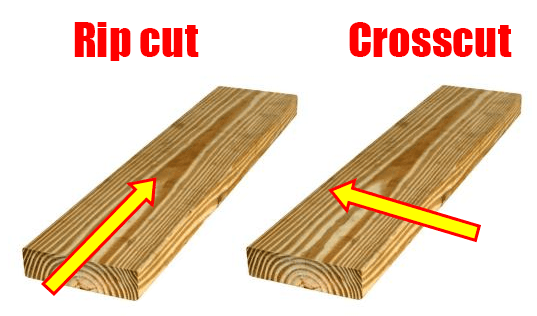
You could crosscut with a table saw, but you would also need a sled for the purpose. Once again, the two table saws in our shed are not fitted with sleds. The other table saw in our shed is a panel saw, has a finer toothed blade and should be used exclusively for panels; melamine, pineboard, mdf and plywood. The panel saw operates with a sled but should not be used to crosscut timber, especially not hardwood.
Choosing The Right Machine
So what’s left I hear you say. Well, you could use a handsaw and a bench hook, pencil and square. A few weeks ago I was using a handsaw and was admonished by a shedder saying “You’re showing your age now!” Of course the answer is the drop saw, also known as a mitre saw or “chop saw”.
Types of Drop or Mitre Saws used for cross cuts:
Original mitre box and saw
The first mitre saws usually consisted of a wooden or plastic three-sided box with 90° and 45° slits to guide a hand or back saw to make mitre cuts in a piece of work.
Power/Standard mitre saw
A powered version designed generally for making straight cross cuts on a piece of work at a wide range of angles. They are commonly used to create 45° degree straight cuts for picture framing.
Compound mitre saw
Compound mitre saws have the added benefit of being able to rotate the blade and head at a variety of angles, allowing for the cutting of angles other than 90 degrees. It creates a ramp angled cut into the side of the wood, allowing for more complex cuts. This type is commonly used in trim work for homes. A compound mitre saw is also sometimes known as a single compound mitre saw, meaning that the head only rotates when angled on oneside, requiring the user to flip the board to get angle cuts in the other direction.
Dual compound mitre saw
Dual or double compound saws allow the head to rotate when angled on both the left and right hand sides. This is mainly used in decorative trim work.
Sliding compound mitre saw
Sliding mitre saws are able to move the saw head back and forth on a sliding rail, similar to a radial arm saw. This increases the size capacity of which a board can be cut. This type of saw can also allow for the locking of the rails to use for straight, pull down cuts (like chop saws). With the sliding feature engaged, the user pulls the head forward, turns on the saw and pushes the blade backwards into the lumber.
Laser/LED mitre saws
Some saws have a laser guide for more precise cutting. The laser is made up of a discshaped washer that attaches to the saw blade and illuminates a line for which where the blade will cut. Some saws also have an LED feature to better illuminate the work area.
Happy Crosscutting
Barry Guest

Community News

We all take for granted the every day things we need, like food, warmth, clean clothes...
At Pete's Place homeless people can drop in to get some essential personal services, such as bathroom and laundry facilities, and food. Pete's Place is adjacent to the Neighbourhood Centre and is run by St Vincent de Paul Society. Since January 141 people have accessed the service on 663 occasions.
The 2016 Census reported 320 homeless people in Coffs Harbour in 2016. The Society's North Coast Executive Officer Michael Timbrell said the usage figures at Pete's Place are no surprise. "The need for these support services was identified in the planning process by the development partners, the Rotary Club of Coffs Harbour South, Coffs Harbour Neighbourhood Centre, Coffs Harbour City Council and St Vincent de Paul Society,” he said.
"Clients gave showering as the main reason for coming in, followed by the need to get food, and to access our laundry,” Mr Tilson said.
"Other priority needs were living aids such as blankets/doonas and toiletries, help in filling out forms or making phone calls, and referrals to other services.”
Mr Timbrell added, "While we're pleased to be providing some basic human dignity it is deeply disturbing
to see how many homeless people there are in the local area, and all across the North Coast."
Soup kitchen gets summer relief

The Coffs Harbour Uniting Church Soup Kitchen has been operating for 28 years. 4 local business men have
paid for the installation of air conditioning for the dining area, which until now has been 'open air'.
Committee chairman Phil Crofts said "The kitchen itself has been air conditioned when a full professional kitchen was installed some 20 years ago, but the dining room remained open to the elements. Coolish in the depths of winter and uncomfortably hot at the height of summer”
The soup kitchen will celebrate 28 years of operation on Sunday, July 1 and hold the annual thanksgiving service.
No more plastic

Woolworths customers are reminded that plastic bags will no longer be supplied after June 20.
Advertising has gone up all around Australia to give customers time to change their habits, and bring their own bags when shopping.
It is expected to save over 3 billion plastic bags a year from entering the waste system.

Focus on Mental Health

MENTAL health conditions are costing Australian businesses billions of dollars each year in absenteeism, increased staff turnover rates and compensation claims. One in six working age people live with mental illness at any point in time - that's more than 800,000 workers across NSW so it's become increasingly important for employers to understand how to support a mentally healthy workplace.
To meet the ever growing awareness of how mental health and stress effects performance in the workplace, local organisation CHESS Employment has developed targeted workshops to help employers collaborate with staff to reduce stigma and promote a culture of positive mental wellness in the workplace. Businesses that actively promote good mental health attract and retain top talent, save money and are great places to work. By supporting the mental wellness of staff and encouraging openness, business leaders can create diverse and productive workplaces.
CHESS is hosting a Leadership Forum on Mentally Healthy Workplaces, Thursday 17th May at the Coffs Surf Club. This 2 hour event is specially designed for business owners and leaders who want to learn more about supporting mental wellness in the workplace. To register for the event visit:
www.chessemployment.com.au/events

Coffs Harbour History
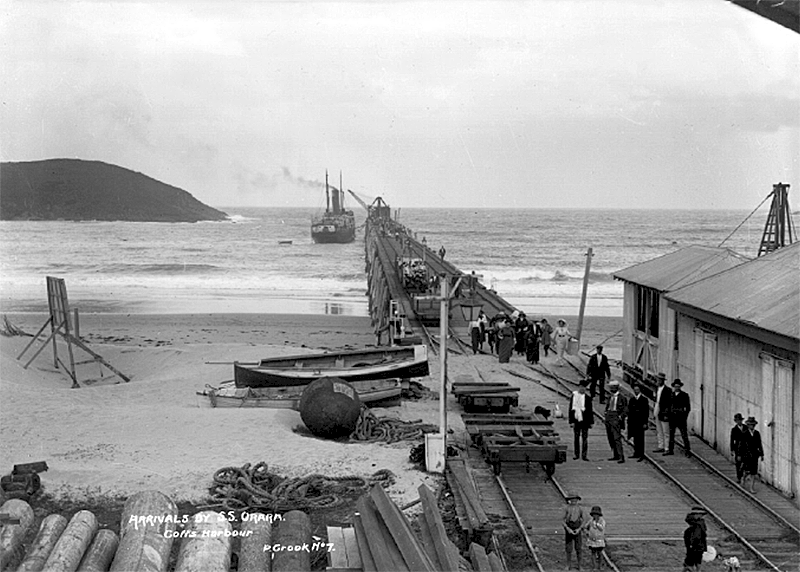
In the year 1890, after much consultation among the leaders of the town and Government at the time, the
construction of the Jetty began. This year was one of the most important years in the early history of the port
and the village of Bralsford. Mr Thomas Dawson, a builder and contractor, arrived at the port in 1890, his special
mission being the erection of a suitable jetty.
A vast collection of piles and timber had been assembled in readiness for the work, and this had all been
obtained locally and sawn in readiness at the sawmill owned by John Mills, the district's first sawmiller, at a spot nearby where the Vacuum Oil Company's depot now stands. The first pile in the construction work on the Jetty was driven by Alfred L. Walsh, a contractor, who arrived about the same year.
During the next three years until 1893, work continued unceasingly (except for bad weather) until the jetty
extended from the shore 1080 feet out into the harbour towards the southern tip of Mutton Bird Island. While
the construction of the jetty was in progress a ship called the "Byron" called at the uncompleted jetty to take on
a cargo of sugar from Alexander Herman's sugar mill at Korora. The Captain of this vessel to call at the jetty
was Captain Hunter, and as the vessel stood only a few feet out of the water, the sugar was taken to the end of
the jetty by means of Mr Lawson's trucks which he kindly lent for the occasion. From there the sugar was loaded
into the "Byron" by means of shutes, which were placed in position from the framework.
SOURCE: http://libraries.coffsharbour.nsw.gov.au/Local-Heritage/Pages/the-development-of-coffsharbour-port.aspx
Supporters of the Coffs Harbour Men's Shed
The Coffs Harbour Community Men's Shed wishes to thank all our supporters, both large and small,
for their ongoing support and generous donations of time and money.
